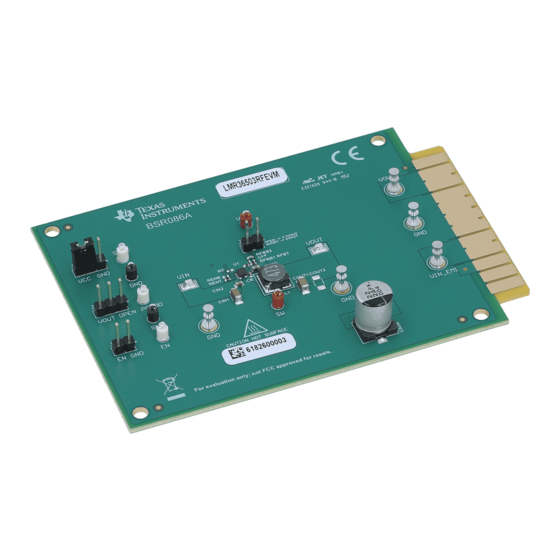
Table of Contents
Advertisement
Quick Links
The Texas Instruments LMR36503RFEVM evaluation module help designers evaluate the operation and
performance of the LMR36503 wide-input buck converters. The LMR36503 is an easy-to-use synchronous
step-down DC/DC converter capable of driving up to 0.3 A of load current from an input voltage of up to
65 V. The LMR36503RFEVM features an output voltage of 3.3 V or 5 V and a switching frequency of 1
MHz. See the
LMR36503 3-V–65-V, 0.3-A Ultra-Small Synchronous Buck Converter with Ultra-Low I
sheet for additional features, detailed descriptions, and available options.
EVM
LMR36503RFEVM
SNVU672 – February 2020
Submit Documentation Feedback
LMR36503RFEVM User's Guide
Table 1. Device and Package Configurations
U1
FREQUENCY
LMR36503RFRPE
1000 kHz
Figure 1. LMR36503RFEVM Board
Copyright © 2020, Texas Instruments Incorporated
SNVU672 – February 2020
SPREAD SPECTRUM
CURRENT
Disabled
0.3 A
LMR36503RFEVM User's Guide
User's Guide
data
Q
PIN 1 TRIM
RT with FPWM
1
Advertisement
Table of Contents

Summary of Contents for Texas Instruments LMR36503RFEVM
- Page 1 DC/DC converter capable of driving up to 0.3 A of load current from an input voltage of up to 65 V. The LMR36503RFEVM features an output voltage of 3.3 V or 5 V and a switching frequency of 1 MHz.
-
Page 2: Table Of Contents
EVM Bottom Copper Layer List of Tables ..................Device and Package Configurations ......................Bill Of Materials Trademarks All trademarks are the property of their respective owners. LMR36503RFEVM User’s Guide SNVU672 – February 2020 Submit Documentation Feedback Copyright © 2020, Texas Instruments Incorporated... -
Page 3: Setup
VCC — This test point is connected to the VCC pin. • SW — This test point is connected to the switch node. Load Input Supply Figure 2. EVM Board Connections SNVU672 – February 2020 LMR36503RFEVM User’s Guide Submit Documentation Feedback Copyright © 2020, Texas Instruments Incorporated... - Page 4 EVM output voltage to 3.3 V whereas adding a jumper sets the output voltage on the EVM to be 5 V. VOUT SELECTION JUMPER MODE/RT SELECTION JUMPER PGOOD SELECTION JUMPER ENABLE OFF JUMPER Figure 3. Jumper Locations LMR36503RFEVM User’s Guide SNVU672 – February 2020 Submit Documentation Feedback Copyright © 2020, Texas Instruments Incorporated...
-
Page 5: Operation
4. Turn on the power supply. With the default configuration, the EVM powers up and provides V = 3.3 5. Monitor the output voltage. The maximum load current must be 0.3 A with the LMR36503 device. SNVU672 – February 2020 LMR36503RFEVM User’s Guide Submit Documentation Feedback Copyright © 2020, Texas Instruments Incorporated... -
Page 6: Schematic
JPGOOD JMODE/RT SH-J1 SNT-100-BK-G VOUT Assembly Note Place SH-J1 on J2 (JMODE/RT) in pin 2 and 3 AGND VINEMI 305-024-521-201 Figure 4. LMR36503RFEVM Schematic LMR36503RFEVM User’s Guide SNVU672 – February 2020 Submit Documentation Feedback Copyright © 2020, Texas Instruments Incorporated... -
Page 7: Top View Of Evm
Board Layout www.ti.com Board Layout Figure 5. Top View of EVM Figure 6. EVM Top Copper Layer Figure 7. EVM Mid Layer One SNVU672 – February 2020 LMR36503RFEVM User’s Guide Submit Documentation Feedback Copyright © 2020, Texas Instruments Incorporated... -
Page 8: Evm Mid Layer Two
Board Layout www.ti.com Figure 8. EVM Mid Layer Two Figure 9. EVM Bottom Copper Layer LMR36503RFEVM User’s Guide SNVU672 – February 2020 Submit Documentation Feedback Copyright © 2020, Texas Instruments Incorporated... -
Page 9: Bill Of Materials
TP12, TP13 SW, VCC Test Point, Miniature, Red, TH Keystone 5000 LMR36503RFRPE LMR36503 Wide Input 65-V Synchronous, DC-DC Buck Texas Instruments LMR36503RFRPET Converter, RPE0009A (VQFN-9) SNVU672 – February 2020 LMR36503RFEVM User’s Guide Submit Documentation Feedback Copyright © 2020, Texas Instruments Incorporated... - Page 10 STANDARD TERMS FOR EVALUATION MODULES Delivery: TI delivers TI evaluation boards, kits, or modules, including any accompanying demonstration software, components, and/or documentation which may be provided together or separately (collectively, an “EVM” or “EVMs”) to the User (“User”) in accordance with the terms set forth herein.
- Page 11 www.ti.com Regulatory Notices: 3.1 United States 3.1.1 Notice applicable to EVMs not FCC-Approved: FCC NOTICE: This kit is designed to allow product developers to evaluate electronic components, circuitry, or software associated with the kit to determine whether to incorporate such items in a finished product and software developers to write software applications for use with the end product.
- Page 12 www.ti.com Concernant les EVMs avec antennes détachables Conformément à la réglementation d'Industrie Canada, le présent émetteur radio peut fonctionner avec une antenne d'un type et d'un gain maximal (ou inférieur) approuvé pour l'émetteur par Industrie Canada. Dans le but de réduire les risques de brouillage radioélectrique à...
- Page 13 www.ti.com EVM Use Restrictions and Warnings: 4.1 EVMS ARE NOT FOR USE IN FUNCTIONAL SAFETY AND/OR SAFETY CRITICAL EVALUATIONS, INCLUDING BUT NOT LIMITED TO EVALUATIONS OF LIFE SUPPORT APPLICATIONS. 4.2 User must read and apply the user guide and other available documentation provided by TI regarding the EVM prior to handling or using the EVM, including without limitation any warning or restriction notices.
- Page 14 Notwithstanding the foregoing, any judgment may be enforced in any United States or foreign court, and TI may seek injunctive relief in any United States or foreign court. Mailing Address: Texas Instruments, Post Office Box 655303, Dallas, Texas 75265 Copyright © 2019, Texas Instruments Incorporated...
- Page 15 TI products. TI’s provision of these resources does not expand or otherwise alter TI’s applicable warranties or warranty disclaimers for TI products. Mailing Address: Texas Instruments, Post Office Box 655303, Dallas, Texas 75265 Copyright © 2020, Texas Instruments Incorporated...











Need help?
Do you have a question about the LMR36503RFEVM and is the answer not in the manual?
Questions and answers